Struers ProntoPress-2 Manuel utilisateur
- Taper
- Manuel utilisateur

Prontopress-2
Instruction Manual
Gebrauchsanweisung
Mode d’emploi
Valid from Serial No.: 3772001
Manual No.:13777003
Date of Release: 09.05.1994

Prontopress-2
Instruction Manual
Safety Precaution Sheet
To be read carefully
before use
1. The operator should be fully aware of the use of the apparatus
according to the Instruction Manual.
2. Be sure that the actual voltage corresponds to the voltage stated on the
back of the apparatus and the heating/cooling unit.
3. Be sure that the water tubings/connections are without leaks.
4. Be sure that the heating/cooling unit is correctly mounted on the press
with the mounting cylinder before starting the process.
5. Be sure that the top closure is correctly mounted, before starting the
process.
6. Keep the mounting pressure below the red area of the manometer.
The equipment is designed for use with consumables supplied by Struers. If subjected to misuse, improper
installation, alteration, neglect, accident or improper repair, Struers will accept no responsibility for
damage(s) to the user or the equipment.
Dismantling of any part of the equipment, during service or repair, should always be performed by a qualified
technician (electromechanical, electronic, mechanical, pneumatic, etc.).

IMPORTANT
Always
state
Serial
No
and
Voltage/fre
-
quency
if
you
have
technical questions
or
when
ordering
spare parts.
You
will
find
the
Serial
No.
and
Voltage
on
the
front
cover
of
this manual
or
on an
attached
label
below.
If
in
doubt
consult
the
rating
plate
of
the
ma-
chine itself.
We
may
also
need
the
Date
and
Article
No
of
the
manual.
This
information
is
found
on
the
front
cover.
The
following restrictions should
be
observed,
as
violation
of
the
restrictions
may
cause
cancellation
of
Struers legal obligations:
Instruction
Manuals
A
Struers
Instruction
Manual
may
only
be
used
in
connection
with
Struers
equipment
covered
by
the
Instruction Manual.
Service
Manuals
A
Struers
Service Manual
may
only
be
used by
a
trained
technician authorized
by
Struers.
The
Service
Manual
may
only
be
used
in
connection
with
Struers
equipment covered
by
the
Service
Manual.
Struers
assumes
no
responsibility
for
errors
in
the
manual
text/illustrations.
The
information
in
this
manual
is
subject
to
changes
without
notice.
The
manual
may
mention
accessories
or
parts
not
included
in
the
present version
of
the
equipment.
The
contents
of
this
manual
is
the
property
of
Struers.
Reproduction
of
any
part
of
this
manual
without
the
written permission
of
Struers
is
not
allowed.
All
rights
reserved.
©
Struers
1994.
Struers
NS
Valhejs
Allé
176
DK-261
0
Rødovre/copenhagen
Denmark
~
Telephone
÷45
36708090
~
Fax
÷4531
41
6544
Prontopress-2
Instruction
Manual
Table
of
Contents
1.
Installation
2.
Operation
3.
Accessories
and
Consumables.
4.
Maintenance
5.
Trouble-Shooting
6.
Technical
Data
Page
5
7
12
15
16
17

Prontopress-2
(Installation)
Instruction
Manual
1.
Installation
1.1
Packing List
1
Prontopress-2
1
Tube spanner
for
fixing bolts, width
13
mm
1
Allen
key 5
mm for
oil
screw,
fig.
2.9, and
draining
screw.
2
Spanners
for
securing
the
lower
ram
(19
and
22
mm)
1
Bayonet
closure
(fig.
1.12)
1
Funnel
1
Measuring
spoon
1
Water
hose
1
Filter
fitting
1
Fitting
1
Transmission fitting
1
Hose for
water outlet
(1,5
m)
1
Hose for
connecting
water
from
base
unit
to
embedding
unit
(0.65
m)
5
Hose clips
1
Fuse
3
Resin
samples
(resin
3,
resin
5
and
resin
6)
1
Mould
Release
Wax
1.1.1
Packing
List
for
Mounting
Cylinder
(Accessory)
The
easily
exchangeable
cylinders come
in
the
following
sizes:
25,
30
and
40
mm
and
1”,
1¼”
and
1½”
inside
diameter.
Apart
from
the
cylinders
the
case
further
contains:
1
Lower
ram
1
Upper
ram
1
Syringe
with
heat
conductive
paste
1.2 Before
First
Time
Use
of
the
Press
The
transit
screw
on
the rear
plate
of
the
press
mentioned
in
the
text
under
“See
manual” must
be
unscrewed
before
using
the press.
Under
the screw
in
the
fitting
situated
in
the rear
plate
is
placed a
piece
of
felt
(meant)
for
purifying
the
air
intake
in
the press. When the
press
is
working
the
hydraulic
oil
gets
hot
and
it
should
be
possible
for
it
to
expand
without
causing
an
excess
pressure
in
the press.
Keep
the screw
for
later user
when moving
the
press from
the
premisses.
Do
not
mount
another
screw
with head
or
the
like.
5

Prontopress-2
(Installation)
Instruction
Manual
1.3
Connection
to
Power, Removal
of
Oil
Screw
Check
the
voltage
and
frequency
on
the
identification
plate
on
the rear
side
of
the press.
Connect
the
base
unit
to
the
mains
voltage
with
a
single-phase plug
to
be
connected
as
follows:
Yellow/green:
earth
Brown:
phase
Blue:
neutral
Remove
oil
screw
(fig.
2.9) to
allow the
press
to
“breathe”.
A
felt disc
under
the screw
prevents
dirt
from
entering.
Keep
the
screw
for
mounting
in
case of
transport
of
press.
1.4
Connection
of
Cooling
Water
Mount
the
hoses
as
follows:
•
The short
hose
between
the
branches
fig.
2.4
and 2.5.
a
The
outlet
hose on
the branch
fig. 2.6.
•
The
inlet
hose on
the
branch
fig. 2.3.
•
The
inlet
hose
is
connected
to
a water
tap.
a
The
outlet
hose
is
taken
to
a
drain.
When
the
hoses
are
connected
to
branch
fig.
2.5
and
fig.
2.6,
make
sure
that
they are
not
pushed
all
the way
up
towards the
back
plate
of
the
mounting
unit.
The
hose
clamps
should
be
firmly
tightened
to
avoid
water
leakage.j
1.5
Assembly
and
Exchange of
Mounting
Cylinder
Screw
the
lower
ram
onto
the
piston
rod
using
the
two keys
19
and
22
mm.
Pull
out
the
locking
pin
on
the
back of
the
flange
(fig.
2.8).
Place
the
cylinder
over
the
lower
ram and
screw
it
into
the
threaded
ring
until
the locking
pin
engages
with the
hole
in
the
cylinder.
Smear
a
layer
of
‘Heat
conductive
paste’
on
the
outer
surface
of
the
cylinder.
Lower
the
embedding
unit
onto
the
cylinder,
after which
the
press
is
ready
for
operation.
To
exchange
the
cylinder
lift
off
the embedding
unit
and
pull
out
the
locking
pin.
Unscrew
the
cylinder
and
demount
the
lower
ram.
Mount
the
new
cylinder
and ram
as described
above.
If
it
proves difficult
to
pull
the
unit
off
the
cylinder,
cool
the
cylinder
down
and
then heat
it
for
10-20
seconds.
This
causes
the
unit
to
expand,
and
it
may
now
easily
be
pulled off.
6

Prontopress-2
(Operation)
Instruction
Manual
2.
Operation
2.1
Introduction
Prontopress-2
is
an
automatic hydraulic
mounting
press
for
metallographic
laboratories.
2.2 Embedding
Unit
The
press
is
supplied
with
an
embedding
unit
incorporating a heating/cooling
element.
Moulding
cylinders
and
rams
are
delivered
separately
according
to
requirement.
The
embedding
unit
will
accept
standard
moulding
cylinders
of
inside
diameters
between
25
and
40
mm
including
1”,
1¼”
and
1½”.
A
thermistor
ensures
accurate
control
of
the
temperature
of
the
heating/cooling
element.
The
pressure
in
the moulding
cylinder
is
established between
the
upper
and
lower
rams.
The
upper
ram
is
kept down
in
the
cylinder by
means
of
a
bayonet
closure
on
the
upper
rim
of
the
cylinder,
and
the
lower
end of
the
cylinder
is
held
in
place
on
the base
unit
by
a threaded
ring.
The
lower
ram
is
placed
on
the
piston
rod,
see
below.
2.3
Base
Unit
The
base
unit
consists
of
a motor
driven
hydraulic
pump,
a
high
pressure
cylinder
and
automatic
controls
for
compressive
force,
heating-
and
cooling
time
and
heating
temperature.
The
compressive
force
is
produced
by a
hydraulic
system
comprising a
pump,
a
high-pressure
cylinder
and
a pressure
regulator.
The pump
is
driven
by a
reversible
electric
motor.
When the
motor
runs
in
one
direction,
the
oil
is
pumped
from
the
reservoir
into
the
primary
side
of
the
high-pressure
cylinder,
and
the piston
rod
ascends. When the
motor
reverses,
oil is
pumped
into
the
secondary
side
of
the
high-pressure cylinder,
whereby
the piston
rod
descends.
7

Prontopress-2 (Operation)
Instruction
Manual
2.4
Controls
Power Switch
(fig.
2.10)
Switch
on
the
press
by
pressing
the power
switch
(fig.
2.10).
The
main
pilot
light
(fig.
1
.8)
turns
on.
Three-way
Toggle
Switch
(fig. 1.2)
Controls
the
position of
the
piston
rod.
Only
when
the
switch
is
set
to
the
neutral
position
in
the
middle
the
press can
perform
the embedding
cycle.
Auto Start
(fig.
1.1)
Starts
the
embedding
cycle,
with
the
preset
heating/cooling
time.
Timers
(fig.
1.4-5)
Heating and
cooling times
can
be
preset,
but
cannot
be
adjusted during
the
operation of
the press.
During
heating
the
(fig.
1
.9)
light
comes
on.
During
cooling
the
(fig.
1
.10)
light
comes
on.
“Force”
(fig.
1.6)
The
pressure
can
be
preset
by
turning
this
knob
and
it
can
be
adjusted
while
the
press
is
operating.
The
pressure
can
be
read
on
the
manometer
and
should
not
exceed
40
kN
(fig.
1.7).
Knob
°C
(fig.
1.3)
The
process
temperature
can
be
adjusted
by turning
the knob
to
the
desired
temperature. Normal setting:
180°C.
Thermo
Fuse
(fig.
2.7)
The
thermo
fuse
protects the
pump
motor
against
overload.
Press
for
reset.
Melting Fuse
(fig.
6.86)
Protects
the
heating/cooling
element
against
overheating.
8

Prontopress-2
(Operation)
Instruction
Manual
2.5
Mounting
Take
the
lower
ram to
its
top
position
by
setting
the
three-way
switch
(fig. 1.2)
to
its
upper
position.
Apply
Mould
Release
Wax
to
the
lower
ram and
place
the
specimen
on
the
lower
ram.
Then
take
the
latter
to
its
bottom
position
by
setting
the
three-way
switch
to
the
lower
position.
Pour
resin
into
the
cylinder
and
apply
Mould
Release
Powder
to
the
upper
part of
the
cylinder
and to
the
upper
ram.
Pass
the
upper ram
so
far
down
into
the
cylinder
that
the
bayonet
closure
can
engage
with
the
cylinder
and
then
turn
the
bayonet
closure
90°
clockwise
by turning
the handle
(green
point
on
the
bayonet
closure
should
be
in
position
opposite
the
corresponding
green
point
on
the
heating/cooling
unit).
Set
the
process
parameters
(see
section
6.2).
Press
(fig. 1.1),
after
which
the
entire
operation
will proceed
automatically.
When
the
cooling
has
stopped,
the
specimen
can
be
removed.
Set
the
three-way
switch
(fig.
1.2)
briefly
to
“down”.
Release
the
bayonet
closure
by turning
it
90°back
using
the handle
(green
point
on
the bayonet
closure
should
be
in
position
opposite
the
corresponding
green
point
on
the
heating/cooling
unit).
Set
the
three-way
switch
to
“up”
for
ejection of
bayonet
closure
and
specimen
from
the
cylinder.
When
the
specimen
has
been
ejected,
set
the
three-way
switch
to
“neutral”,
and
the
press
is
ready
for
the
next
mounting.
2.6
Mounting
Data
The
data
stated below
should
be
considered as a guide
for
obtaining
a
perfect,
completely
cooled
mount.
Depending
on
the
individual
demands
to
the mount, the
specimen
size
and
the
type
and
quantity
of
resin,
the
listed
times
can
be
optimized. See
also
the
chapter
“Hints”.
Suggested
data
for
all
resins:
Cylinder
Dia.
Quantity Pressure Heating Time
Cooling
Time
25
mm/i”
20
ml
15
kN
6
mm
4
mm
30
mm/i
¼”
30
ml
20
kN
8
mm
4
mm
4Omm/1½”
40m1
35kN
10mm
4mm
NB
Thermostat
on
maximum.
When
using
Resin
3,
the
supply
of
cooling
water
must be
reduced
to
0.1
I/mm.
9

2.7
Hints
Resin
1
and
3
Resin
3
is
not
electrically
conductive,
can
be
used
in
conjunction
with
Resin
1
to
provide
an
insulating surface
with
Resin
1
as
the
conductive
backing.
Resin
4,
5
and
6
When
using
the rather expensive resins
4
and
5,
these
can
be used
in
the
bottom
of
the
cylinder,
which
is
then filled
up
with the
less
expensive
bakelite
resin.
Pre-mount
Pre-mount
is
best
suited
for
routine
mounting
of
large
numbers of
specimens
where,
due to
their
compact
form
and
the addition
of
an
intermediate
ram,
two
mounts can
be
produced
in
one
process
(max.
040
mm).
Because of
its
compact
form,
Pre-mount already
exerts
a
certain
pressure
on
the
specimen
from
the
start
of
the
mounting
process,
making
it
suitable
for
use only
with
pressure-resistant
specimens.
Mould
Release
Wax
Distance
to
cylinder
wall
Small
specimens
Clean
specimens
Must
always
be
applied
to
the
mounting
rams
in
a
thin
layer
before
the
mounting
process
begins. This
prevents
the adhesive
qualities
of
the resins
from making
it
difficult
to remove
the
mounts
afterwards.
The
distance
between
the
specimen
and
the
cylinder
wall
must
be
minimum
3
mm (1/8”)
to
avoid cracks
in
the
resin.
This
goes
especially
for
specimens
with
sharp
edges.
Small
thin
specimens
can
be
stabilized by
means
of
Struers
mounting
clips,
available
in
metal
and
in
plastic
(see
the
chapter “Consumables”).
The
specimens
must
be
clean,
dry
and
free
from
grease.
If
necessary
clean
with
alcohol
or
another
suitable
degreasing
fluid.
Pressure
Preheating
The
recommended
maximum
pressures
vary
from
15
kN for
025
mm
to
35
kN for
o40
mm
specimens.
The pressure
must
never
exceed
55
kN
and
be
less
than
15
kN.
For
porous
and/or
pressure
sensitive
specimens,
such
as
minerals,
electronic
parts
etc.,
it
is
an
advantage
to
soften the
resin
by
heating,
before
applying pressure.
This
is
mostly
advantageous
when
using
thermoplastic
resins
and
especially
Resin
3.
Example of
time parameters
to
be
used
together
with
Resin
3:
Preheating
with
low
pressure:
12
mm
Heating
with
pressure:
½
mm
Cooling:
5
mm
Prontopress-2
(Operation)
Instruction
Manual
10

Heating
time
The
heating
time
can
be
optimized
depending
on
the
specimen
size
and
the
quantity
of
resin
used.
Cooling
time
A
cooling
time
of
4-5
mm
ms
mostly
suitable. Note that
when
Resin
3
is
used,
the
supply
of
cooling
water
should
be
reduced
to
0.1
1/mm. It
is
also
sometimes necessary
to
increase
the
cooling time
for
Resin
3.
Temperature
Porous
specimens
Pressure
sensitive
specimens
Temperature
sensitive
specimens
The mentioned
heating/cooling
times
are
based
on
the
thermostat
being
set
on
maximum.
If
the
temperature
is
reduced the
recommended
heating time
should
be
longer.
The
temperature
used
during
the
mounting
process
can
be
reduced
to
a
minimum
of
110°C
for
all
resins.
Thermoplastic
resins
(especially
Resin 3)
penetrate
well
into
porous
specimens.
The
best
results
are
obtained
by
preheating
the
resin
(see
“Preheatmng”).
NB
For
very
porous
specimens,
hot
compression mounting
should
be
avoided.
Cold
mounting
should
be used
instead (Epof
ix
with vacuum
impregnation).
Thermoplastic
resins
(especially
Resin
3)
should
be
used.
The
best
results
are
obtained
by
preheating
the
resin
(see
“Preheating”).
NB
For
very
pressure
sensitive
specimens,
hot
compression
mounting
should
be
avoided.
Cold
mounting
should
be used
instead.
The
temperature
used
during
the
mounting
process
can
be
reduced
to
a
minimum
of
110°C
for
all
resins.
NB
For
very
temperature
sensitive
specimens,
hot
compression
mounting
should
be
avoided.
Cold
mounting
(Epofix)
should
be used
instead.
Prontopress-2
(Operation)
Instruction
Manual
11

Prontopress-2
Instruction
Manual
3.
Accessories and
Consumables
3.1
Accessories
(Accessories)
Soecification
Code
Top
closures
Standard
bayonet
closure
Advanced bayonet
closure.
Makes
it
possible
to
place
the
upper
ram
individually,
according
to
the
height
of
the specimen. Built-in
device
secures
easy
opening
and
cIosin~
PREBA
PRENY
Mounting
cylinder
set
Mounting
cylinder
set,
including upper
ram and
lower
ram,
interchangeable:
Diameter
25
mm
Diameter
1”
Diameter
30
mm
Diameter
1¼”
Diameter
1½”
Diameter
40
mm
PROMI
PROON
PROTE
PROQU
PROHA
PROIF
Intermediate
ram
Makes
it
possible
to
mount
two
specimens
simulta-
neously. Please
state cylinder
diameter
PRODO
Struers Engraver,
complete
With
1
hard point,
220
V,
50-60
Hz
As
above,
but
115
V,
50-60
Hz
ENGRA
ENGRA
12

Prontopress-2
(Accessories)
Instruction
Manual
3.2 Consumables
Hot
compression
mounting
resins
Resin
1
and
3
are thermoplastic.
Resin
4, 5,
6
and Pre-mount
are
thermosetting.
Resin
Characteristics Application
Code
(Quantity)
Resin
1
Material:
acrylic
Classification:
thermoplastic
Powder
color:
dark grey
Filler: Fe-powder
Specific
property:
electrically conductive
Mounting
of ferrous
specimens
and
aluminium
alloys
for
e.g.
electrolytic
polishing
RESFE
(net
0.75
kg)
Resin
3
(transparent)
Material:
acrylic
Classification:
thermoplastic
Powder
color:
white
Specific
properties:
transparent,
low viscosity
Mounting
of
irregularly
shaped specimens
and
of
specimens with
a
rough
surface.
Penetrates
well
into
cracks
and
pores.
Provides
crystal-clear mounts
-
a
major
benefit
if
the
objective
is
to
grind
to
a
certain
point
in
the
specimen
RESNO
(net
0.75
kg)
RESYV
(net
7.5
kg)
Resin
4
Material: diallylphtalate
Classification: thermosetting
Powder
color:
green
Filler: glass fibers
Specific
properties:
hard,
wear
resistant,
highly
resistant
to
chemicals
The
glass fibers result
in
a
very
hard
mount.
This
resin
is
a
good
choice
when
specimens
with
high
edge
retention
and
planeness are
required
RESDI
(net
0.75
kg)
RESTY
(net
7.5
kg)
Resin
5
Material:
epoxy
Classification:
thermosetting
Powder
color: black
Filler: minerals, glass fibers
Specific
properties:
hard,
wear
resistant,
highly
resistant
to
chemicals
This
epoxy
resin,
containing
minerals
and
glass
fibers,
gives
a
very
hard
mount.
Due
to
its
outstanding
adhesion
to
the
specimen
it
provides
an
extremely
good
edge
retention.
Suitable
for
all
purposes
requiring
optimal
edge
retention
and
plane-
ness
RESIF
(net
0.75
kg)
RESEN
(net
7.5
kg)
Resin
6
Material:
phenolic
(bakelite)
Classification:
thermosetting
Powder
color:
brown
Filler: wood
Specific
~operty:
inexpensive
Serial
mounting.
Especially
suitable
for
routine
mounts
RESBA
(net
0.70
kg)
RESUK
(net
7.5 kg)
Pre-mount
Material:
phenolic
(bakelite)
Classification:
thermosetting
Color:
black
Filler: wood
Specific
properties:
easy
to
handle,
extremely
uniform
mounts
Shape:
cylindrical pills
for
cyl.dia.
25
mm!1
‘,
height
16
mm
(RESUN)
for
cyl.dia.
30
mm!11/4,
height
16mm
(RESGI)
for
cyl.dia.
40
mrrill
1/2~’,
height
16
mm (RESAM)
Serial
mounting
of
specimens
of
uncomplicated
shapes.
The pills
can
be
immediately placed
in
the
mounting
press.
Quick,
easy
and
clean
to use
RESUN
(net
10
kg!
about
1100
pcs.)
RESGI
(net
10
kg!
about.
760
pcs.)
RESAM
(net
10
kg!
about
460
pcs.)
13

Prontopress-2
Instruction
Manual
(Accessories)
Code
Mould
Release
Wax
Heat
Conductive
Paste
Fixation
Clips
Multiclips
Sample Identification
Discs
Prevents the
specimens
from
sticking to
the
rams,
net
53
g
Paste
for
improving the
heat
transmission between
the
mounting
cylinder
and
the
heating/cooling
unit,
net
100
g
Metal clips for
retaining
small
specimens,
9
mm,
100
pcs
Same
as
above, but
6
mm,
100
pcs
Plastic
clips for
retaining
small
specimens,
50 pcs.
Struers
Sample
Identification
Discs,
pack of
20
sheets,
each
containing
15
discs
PREWA
PREPA
CLIPS
.CLIMO
CLIPE
IDENT
14

Prontopress-2
Instruction
Manual
4.
Maintenance
(Maintenance)
Apart
from
cleaning
and
exchange
of
oil
the base
unit
requires
no
regular
maintenance.
However, moving
parts
may
be
greased.
Fuse
(fig.
2.11) For
replacement
of
the
fuse,
unscrew
the
black
plastic button
and remove
the
fuse.
Replace
with
fuse
of
the
right
amperage.
4.1
Cleaning
Clean with
a
dry
cloth
(do
not
use
compressed
air).
Moulding
cylinders
and
rams
must
be
kept
clean.
The
cylinder
may
be
cleaned
by passing
the
lower
ram
up
through
the
cylinder
without
producing
a
mount.
For
a
more
thorough
cleaning
remove
the
cylinder. Cylinder
and
rams
are
cleaned
in
alcohol
or
acetone
or
possibly
in
an
ultrasonic
cleaner.
Rams
may
be
polished
with
6
pm
or
3
pm
diamond
on
a
soft
polishing
cloth
(DP-Nap).
4.2
Exchanging
the
Oil
The
hydraulic
oil
must
be
exchanged
at
intervals.
The
first
oil
exchange
must
take place
after
1000
hours of operation
and,
after
that,
at
every
3000
hours
of
operation,
or at
intervals
of
max. 10
years.
The
press
is
drained
of
oil
through
the drain
plug
in
the
bottom
of
the press.
When
the
press
has been
drained
of
oil,
the
embedding
unit
(fig.
1.11)
is
removed, and
the
press
is
turned
upside
down. Now
3
I
of
oil
are
filled
through
the
drain
hole
and
the
plug
is
mounted.
Recommended
type
of
oil
Mobil
DTE
18
or
similar
hydraulic
oil
having
a
viscosity
of
95c
St
(12°E)
at
40°C.
15

Prontopress-2
Instruction
Manual
5.
Trouble-Shooting
(Trouble-Shooting)
Error
I
Cause
I
Action
Resin
1
or3
Lack
of conductivity
No
contact
to specimen due to
use
of
an
excessive
amount
of
Resin
3
Make a
new
mount.
Possibly place
the
entire
mount
with specimen
in
a
slightly
larger
cylinder
Lack
of
conductivity
Insufficient curing
of
resin
Reinsert mount
in
the
press for
re
-
processing
at
prolonged
heating
times
The
metal
particles
are
removed in
the
electrolytic
process
Excessive grinding time
Too
little
amount
of
Resin
3
Make
a
new mount
Use
more
Resin
3
Resin
3
Whiteness
on
specimen
surface
or
in
the
middle
of specimen
Insufficient curing
(moist
resin)
Prolong heating
time
possibly
repro-
cess
the
faulty mount.
The
resin
may
be
dried
by
exposing
the
open
con
-
tainer
to
30°-70°C
Mount
white
or
cotton
balled,
espe-
cially
if
the
mount
is
high
Too
rapid
cooling
insufficient curing
(moist
resin)
Reduce
height
of
mount.
Lower
the
temperature
and
prolonged
the
heat
-
ing
time.
Reduce
the
cooling
water
supply
and prolong
cooling
time.
Resin
4
Bulging
mount
Insufficient
cooling
Increase
the
cooling
time
Individual
grains
visible
in
the
resin
Insufficient
curing
Increase
the heating
time
and/or
temperature
Specimen
sticks to
the
ram
No
Mould Release
Wax
applied/heating
too
brief
Apply
Mould Release
Wax.
Heat
longer
Resin
6
and
Pre-moulds
Bulging
mounts
Parts
of mount
become
light
or
color-
less
on
contact with
alcohol
Insufficient cooling
Insufficient
curing
Increase
cooling
time
Increase heating
time and/or
temper
-
ature
16

Power
Process
temperature
6.
Technical
Data
6.1
Embedding
Unit
Voltage
Power
Compressive
force
External
dimensions
Weight
Fuses
6.2
Base
Unit
220
V
or
115
V,
50-60
Hz.
270
W
0-40
kN
Width:
300
mm
Depth:
330
mm
Height:
530
mm
47kg
115
V
16
AT
220 V 8 AT
Prontopress-2
Instruction
Manual
(Technical
Data)
1400
W
105°-i
85°C
(221
°-365°F)
Cooling
coil
6
x
4,3
mm dia.
copper pipe for
tap
water:
0-16°C
(32°-60°F)
17

Prontopress-2
Gebrauchsanweisung
Prontopress-2
Sicherheitshinweise
Vor
Gebrauch
bitte
sorgfa~tig
lesen
1.
Der
Operateur
soilte
mit
der
Anwendung
des
Gerates
laut
der
Gebrauchsanweisung
vertraut
sein.
2.
Nicht
vergessen
zu
kontroUieren,
ob
die
vorhandene
Spannung
der
auf
der
Ruckseite des
Gerätes
und
auf
der
Heiz/Kuhleinheit angefuhrten
Spannung
entspricht.
3.
Dafür
sorgen,
daB
die
Wasserschläuche/Ver
-
bindungen
dicht sind.
4.
Dafür sorgen
daB
die
Heiz/Kühleinheit
korrekt
auf
der
Presse
mit dem
Einbettungszylinder
montiert
ist,
bevor
der
Vorgang gestartet
wird.
5.
Dafür
sorgen,
daB
der
obere
VerschluB
korrekt
montiert
ist,
bevor der
Vorgang gestartet
wird.
6.
Den
Einbettungsdruck
unter
dem
roten
Feid
des
Manometers
halten.
Für
die
Benützung
der
Gerate bzw.
der
Macchinen
sind
die
Verbrauchsmaterialien
von
Struers
vorgesehen.
Falls
unzulassiger
Gebrauch,
ialsche
Installation, Veranderung, Vernachlässigung,
unsachgemal3e
Reparatur
oder
em
Unfatl
vorliegt,
übernimmt
Struers
weder die
Verantwortung
für
Schäden
des
Benutzers,
noch
für
solche
am
Gerat.
Die
für
Kundendienst
und
Reparatur
erforderliche
Demontage irgendwelcher
Teile
des
Gerätes
bzw.
der
Maschine
sollte
immer
nur
von
qualifiziertem
Fachpersonat
(Elektromechanik, Elektronik, Pneumatik
usw.)
vorgenommen
werden.

WICHTIG
Geben
Sie
blUe
bet
technischen
Anfragen
oder bet
der
Besteltung
von
Ersatzteiten
immer
die
Seriennummer
und
die
Span-
nun
g/Frequenz
an.
Diese
Angaben
finden
ste
entweder
auf
dem
Deckblatt
der
vortiegenden
Gebrauchsanweisung,
auf
dem
unten
angebrachten
Schitd
oder
auf
dem Typenschitd
des
Gerätes
setbst.
Datum
und
Artikelnummer
der
Gebrauchs
-
anweisung
sind
u.U.
auch
zu
nennen.
Diese
Information
finden
Ste
ebenfatis
auf
dem
Deckbtatt.
Beachten
Sie
bitte
die
nachstehend
genannten
Einschrankungen.
Zuwiderhandlung
kann
die
Haftung
der
Firma
Struers
beschrttnken
oder
aufheben:
Gebrauchsanweisunpen
Eine
von
der
Firma
Struers
verOffentlichte
Gebrauchsanweisung
dart
nur auf
solche
Struers
Gerttte
angewendet
werden,
für
die
diese
Gebrauchsanweisung
ausdrücklich
bestimmt
ist.
Wartunpshandbücher
Em
von
der
Firma
Struers
verOffentlichtes
Wartungshandbuch
dart
nur
von
ausgebildeten
Technikern
benutzt
werden,
die
von
Struers dazu
berechtigt wurden. Das
Wartungshandbuch
dart
nur
für
die
Struers
Gerãte
angewendet
werden,
für
die
es
ausdrücklich
bestimmt
ist.
Struers
übemimmt für lrrtümer
in
Text
und Bild
der
Veroffenttichungen
keine
Verantwortung.
Wir
behalten
uns das
Recht vor, den
Inhalt
der
Gebrauchsanweisungen
und
Wartungshandbü
-
cher jederzeit
und
ohne
Vorankündigung
zu
ändern.
In
den
Gebrauchsanweisungen
und
Wartungshandbüchern
können
Zubehär
und
Teile
erwähnt
sein,
die
nicht
Gegenstand
oder
Teil
der
laufenden Gerateversion
sind.
Der
Inhatt
der
Gebrauchsanweisungen
und
Wartungshandbücher
ist Eigentum
der
Firma
Struers.
Kein
Tell dart
ohne
schriftliche
Geneh
-
migung
des
Herausgebers
reproduziert
werden.
Alle
Rechte
vorbehalten
©
Struers
9.
Mai
1994.
Struers
A/S
ValhøjsAlle
176
DK-261
0
Rødovre/Copenhagen
Denmark
~
Telephone
+45
36
708090
~Fax+4531 416544
Prontopress-2
Gebrauchsanweisung
Inhaltsverzeichnis
Seite
1
Inbetriebnahme
23
2.
Bedienung
25
3.
Zubehor
und
Verbrauchsmaterialien
30
4.
wartung
33
5..
Fehlersuche
34
6..
Technische
Daten
35


Prontopress-2 (Inbetriebnahme)
Gebrauchsanweisung
1.
lnbetriebnahme
1.1
Packliste
1
Prontopress-2
1
RohrschluBel
für
Befestigungsbolzen,
13 mm
SchlüBelweite
1
lmbuBschlüBel (5
mm)
für
Olschraube
(Fig.
2.9) und
Ent
-
leerungsschraube.
2
GabelschlüBel
für
den Unterstempel
(19
und 22
mm)
1
Topbajonett
(Fig.
1.12)
1
Trichter
1
MeBlöffel
1
Wasserschlauch
1
Filterarmatur
1
Armatur
1
Transmissionsarmatur
1
Schlauch
für
Wasserablauf
(1,5
mm)
1
Schlauch
für
Wasserverbindung
von
Grundeinheit
zur
Einbettungseinheit
(0,65
m)
5
Spannbänder
1
Sicherung
3
Resinproben (Resin
3,
Resin
5
und
Resin
6)
1
Mould Release
Wax
(Gleitmittel)
1.1.1
Einbettungszylinder
(Zubehör)
Die
leicht
auswechselbaren
Zylinder
sind
in
den
GröBen
25,
30
und
40 mm
und
1
“,
1.1/4” und
1.1/2”
lieferbar.
AuBer
dem Zylinder
gibt
es:
1
Unterstempel
1
Oberstempel
1
Spritze
mit
wärmeleitender
Paste.
1.2
Bevor
Gebrauch der
Presse
Die
im
Texte
unter
“Siehe Manual”
erwähnte
Föderschraube
an
der
hinterwand
der
Presse
soIl
bevor
der
Presse
abgeschraubt
werden.
Unter
der
Schraube
in
der
an
der
Hinterwand plazierten
Armatur
ist
em
Stückchen
Filt
zur
Reinigung
des
Luftansaugs angebracht.
Wenn
die
Presse
arbeitet,
wird
das
hydraulische
01
angeheizt
und
muB
dafür
de
MOglichkeit
haben
sich
auszudehnen,
ohne
daB
in
der
Presse
em
Uberdruck
entsteht.
Die
Schraube
müBte
für
eine
eventuell
spätere
Forderung aufgehoben
werden.
Keine
neue
Schraube
mm
z.B.
einem
Loch
oder
ähnlichem
soIl
eingeschraubt
werden.
23
La page est en cours de chargement...
La page est en cours de chargement...
La page est en cours de chargement...
La page est en cours de chargement...
La page est en cours de chargement...
La page est en cours de chargement...
La page est en cours de chargement...
La page est en cours de chargement...
La page est en cours de chargement...
La page est en cours de chargement...
La page est en cours de chargement...
La page est en cours de chargement...
La page est en cours de chargement...
La page est en cours de chargement...
La page est en cours de chargement...
La page est en cours de chargement...
La page est en cours de chargement...
La page est en cours de chargement...
La page est en cours de chargement...
La page est en cours de chargement...
La page est en cours de chargement...
La page est en cours de chargement...
La page est en cours de chargement...
La page est en cours de chargement...
La page est en cours de chargement...
La page est en cours de chargement...
La page est en cours de chargement...
La page est en cours de chargement...
La page est en cours de chargement...
La page est en cours de chargement...
La page est en cours de chargement...
La page est en cours de chargement...
La page est en cours de chargement...
La page est en cours de chargement...
La page est en cours de chargement...
La page est en cours de chargement...
La page est en cours de chargement...
La page est en cours de chargement...
La page est en cours de chargement...
La page est en cours de chargement...
La page est en cours de chargement...
La page est en cours de chargement...
La page est en cours de chargement...
La page est en cours de chargement...
La page est en cours de chargement...
La page est en cours de chargement...
La page est en cours de chargement...
La page est en cours de chargement...
La page est en cours de chargement...
-
 1
1
-
 2
2
-
 3
3
-
 4
4
-
 5
5
-
 6
6
-
 7
7
-
 8
8
-
 9
9
-
 10
10
-
 11
11
-
 12
12
-
 13
13
-
 14
14
-
 15
15
-
 16
16
-
 17
17
-
 18
18
-
 19
19
-
 20
20
-
 21
21
-
 22
22
-
 23
23
-
 24
24
-
 25
25
-
 26
26
-
 27
27
-
 28
28
-
 29
29
-
 30
30
-
 31
31
-
 32
32
-
 33
33
-
 34
34
-
 35
35
-
 36
36
-
 37
37
-
 38
38
-
 39
39
-
 40
40
-
 41
41
-
 42
42
-
 43
43
-
 44
44
-
 45
45
-
 46
46
-
 47
47
-
 48
48
-
 49
49
-
 50
50
-
 51
51
-
 52
52
-
 53
53
-
 54
54
-
 55
55
-
 56
56
-
 57
57
-
 58
58
-
 59
59
-
 60
60
-
 61
61
-
 62
62
-
 63
63
-
 64
64
-
 65
65
-
 66
66
-
 67
67
-
 68
68
-
 69
69
Struers ProntoPress-2 Manuel utilisateur
- Taper
- Manuel utilisateur
dans d''autres langues
- English: Struers ProntoPress-2 User manual
- Deutsch: Struers ProntoPress-2 Benutzerhandbuch
Documents connexes
-
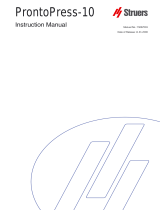 Struers ProntoPress-10 Manuel utilisateur
Struers ProntoPress-10 Manuel utilisateur
-
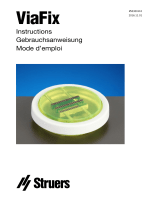 Struers ViaFix Manuel utilisateur
Struers ViaFix Manuel utilisateur
-
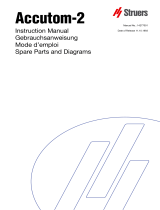 Struers Accutom-2 Manuel utilisateur
Struers Accutom-2 Manuel utilisateur
-
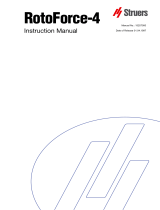 Struers RotoForce-4 Manuel utilisateur
Struers RotoForce-4 Manuel utilisateur
-
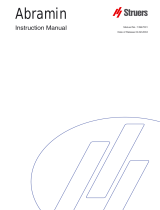 Struers Abramin Manuel utilisateur
Struers Abramin Manuel utilisateur
-
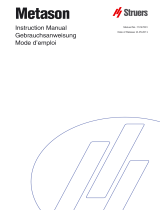 Struers Metason Manuel utilisateur
Struers Metason Manuel utilisateur
-
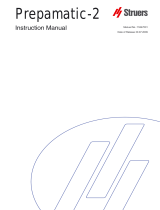 Struers Prepamatic-2 Manuel utilisateur
Struers Prepamatic-2 Manuel utilisateur
-
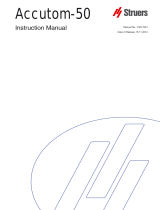 Struers Accutom-50 Manuel utilisateur
Struers Accutom-50 Manuel utilisateur
-
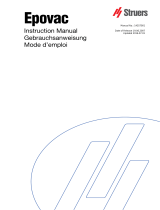 Struers Epovac Manuel utilisateur
Struers Epovac Manuel utilisateur
-
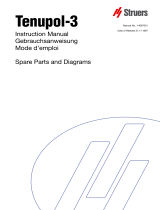 Struers Tenupol-3 Manuel utilisateur
Struers Tenupol-3 Manuel utilisateur














































































